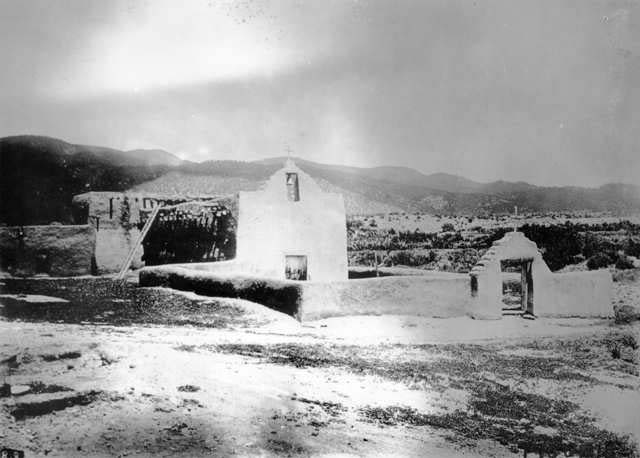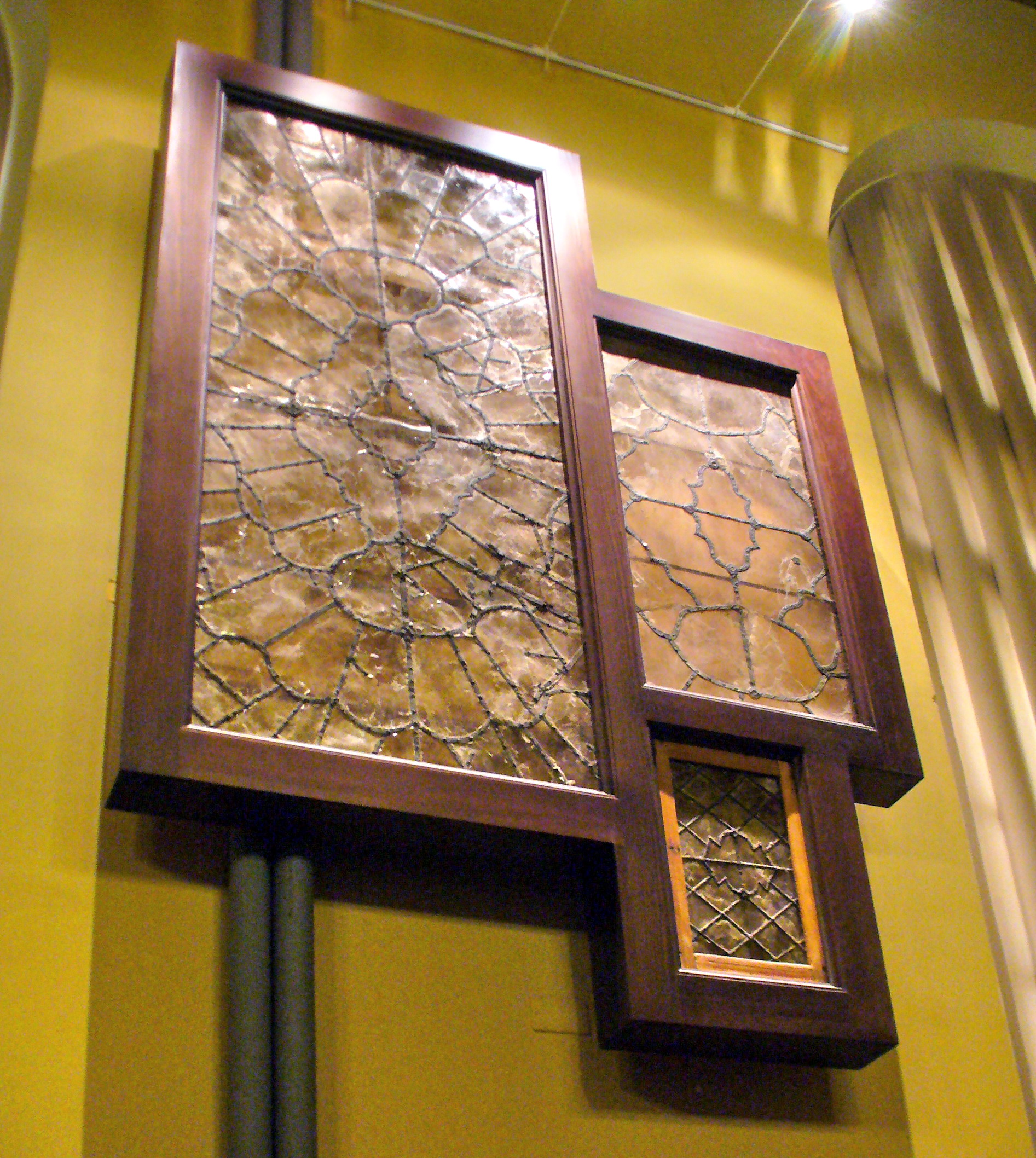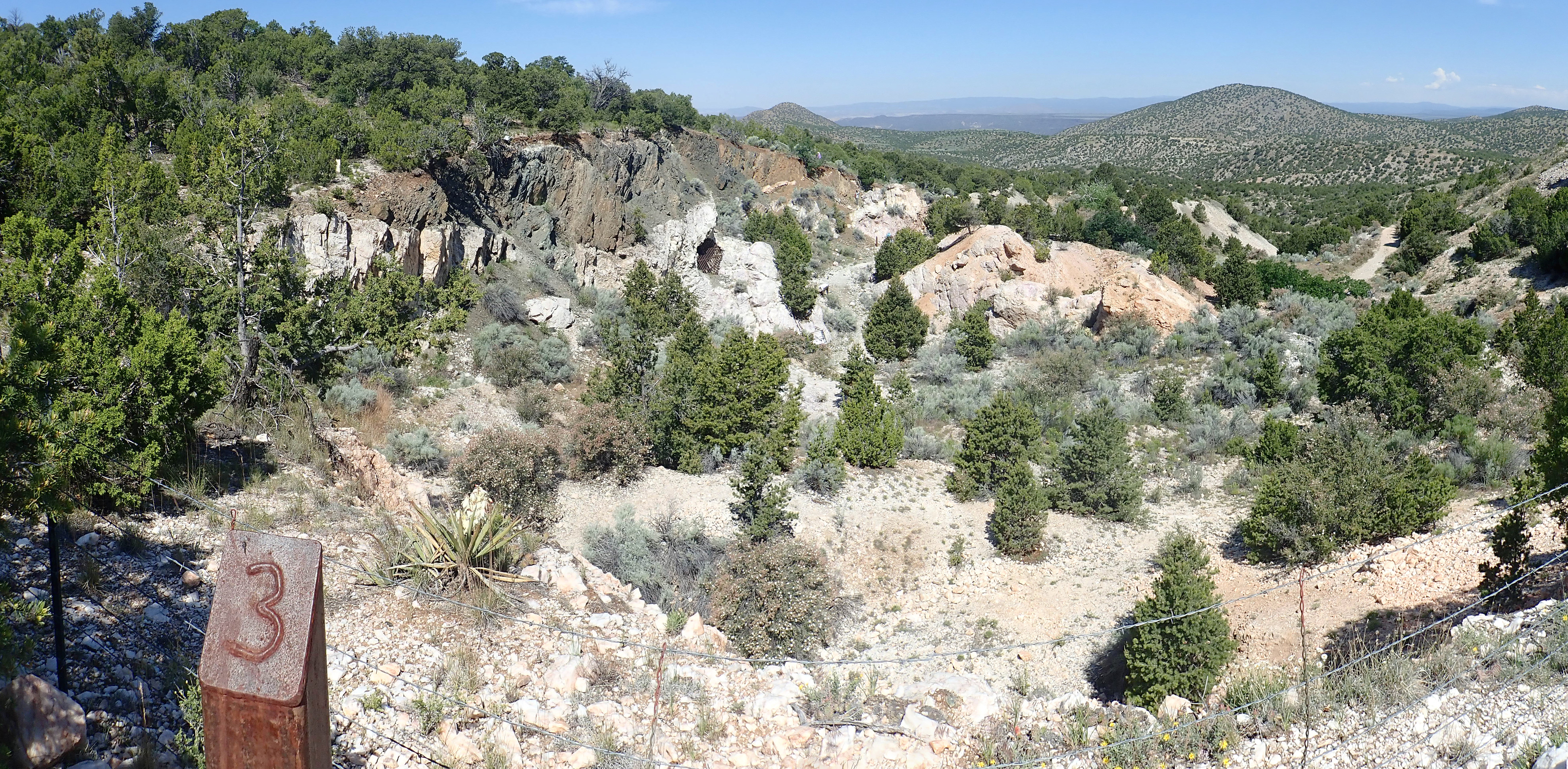|
Picuris Mountains
The Picuris Mountains are a mountain range in northern New Mexico. They are considered a subrange of the Sangre de Cristo Mountains. Geography The mountains are located to the east of Dixon and surround Picuris Pueblo to the west, north, and east. The range resembles a triangle with its base to the east, along the valley of the Rio Grande del Rancho. The northwest face lies along the valley of the Rio Grande and the southern face lies along Rio Pueblo and Embudo Creek. History The area was first visited by Europeans on July 13, 1598, when Juan de Oñate visited Picuris Pueblo. Geology The range is underlain by Precambrian rock beds of the Hondo Group and Vadito Group. It is the namesake for the Picuris orogeny. Economy Mining has been historically important in the Picuris Mountains. The Harding Pegmatite Mine was operated off and on from about 1900 to 1958, when it was donated to the University of New Mexico as an outdoor geological laboratory. At one time, the mine made ... [...More Info...] [...Related Items...] OR: [Wikipedia] [Google] [Baidu] |
Picuris Pueblo, New Mexico
Picuris Pueblo (; Tiwa: P'įwweltha ’ī̃wːēltʰà is a historic pueblo in Taos County, New Mexico, United States. It is also a census-designated place (CDP) and a federally recognized tribe of Native American Pueblo people. The 2010 census estimated that 68 people lived in the CDP, while 267 people in the U.S. reported being of the tribal group Picuris alone and 439 reported being of the tribal group Picuris alone or in combination with other groups. Picurís Pueblo is a member of the Eight Northern Pueblos. Their own name for their pueblo is ''P'įwweltha'', meaning "mountain warrior place" or "mountain pass place." They speak the Picuris dialect of the Northern Tiwa language, part of the Kiowa-Tanoan language family. Geography Picuris Pueblo is located in northern New Mexico, on the western slopes of the Sangre de Cristo Mountains and 18 miles south of Taos Pueblo. Average elevation in the pueblo is over 7,000 feet.Pritzker, Barry M. ''A Native American Encyclopedia: His ... [...More Info...] [...Related Items...] OR: [Wikipedia] [Google] [Baidu] |
Picuris Orogeny
The Picuris orogeny was an orogenic event in what is now the Southwestern United States from 1.43 to 1.3 billion years ago in the Calymmian Period of the Mesoproterozoic. The event is named for the Picuris Mountains in northern New Mexico and interpreted either as the suturing of the Granite-Rhyolite crustal province to the southern margin of the proto-North American continent Laurentia or as the final suturing of the Mazatzal crustal province onto Laurentia. According to the former hypothesis, this was the second in a series of orogenies within a long-lived convergent boundary along southern Laurentia that ended with the ca. 1200–1000 Mya Grenville orogeny during the final assembly of the supercontinent Rodinia, which ended an 800-million-year episode of convergent boundary tectonism. Description Age and isotope data show that southern North America is composed of a series of northeast-trending provinces representing island arc terranes accreted onto the 1800 Mya core of Lauren ... [...More Info...] [...Related Items...] OR: [Wikipedia] [Google] [Baidu] |
Muscovite
Muscovite (also known as common mica, isinglass, or potash mica) is a hydrated phyllosilicate mineral of aluminium and potassium with formula K Al2(Al Si3 O10)( F,O H)2, or ( KF)2( Al2O3)3( SiO2)6( H2O). It has a highly perfect basal cleavage yielding remarkably thin laminae (sheets) which are often highly elastic. Sheets of muscovite 5 meters × 3 meters (16.5 feet × 10 feet) have been found in Nellore, India. Muscovite has a Mohs hardness of 2–2.25 parallel to the 01face, 4 perpendicular to the 01and a specific gravity of 2.76–3. It can be colorless or tinted through grays, browns, greens, yellows, or (rarely) violet or red, and can be transparent or translucent. It is anisotropic and has high birefringence. Its crystal system is monoclinic. The green, chromium-rich variety is called fuchsite; mariposite is also a chromium-rich type of muscovite. Muscovite is the most common mica, found in granites, pegmatites, gneisses, and schists, and as a contact metamorphic ro ... [...More Info...] [...Related Items...] OR: [Wikipedia] [Google] [Baidu] |
Aluminosilicates
Aluminosilicate minerals ( IMA symbol: Als) are minerals composed of aluminium, silicon, and oxygen, plus countercations. They are a major component of kaolin and other clay minerals. Andalusite, kyanite, and sillimanite are naturally occurring aluminosilicate minerals that have the composition Al2 Si O5. The triple point of the three polymorphs is located at a temperature of and a pressure of . These three minerals are commonly used as index minerals in metamorphic rocks. Naturally occurring microporous, hydrous aluminosilicate minerals are referred to as zeolites. Feldspar is a common tectosilicate aluminosilicate mineral made of potassium, sodium, and calcium cations surrounded by a negatively charged network of silicon, aluminium and oxygen atoms. The catalyst silica-alumina is an amorphous substance which is not an aluminosilicate compound. Aluminosilicate glasses There exist a wide variety of glass types. The characteristics of these different types depend on th ... [...More Info...] [...Related Items...] OR: [Wikipedia] [Google] [Baidu] |
Bismuth
Bismuth is a chemical element with the Symbol (chemistry), symbol Bi and atomic number 83. It is a post-transition metal and one of the pnictogens, with chemical properties resembling its lighter group 15 siblings arsenic and antimony. Elemental bismuth occurs naturally, and its sulfide and oxide forms are important commercial ores. The free element is 86% as dense as lead. It is a brittle metal with a silvery-white color when freshly produced. Passivation (chemistry), Surface oxidation generally gives samples of the metal a somewhat rosy cast. Further oxidation under heat can give bismuth a vividly Iridescence, iridescent appearance due to thin-film interference. Bismuth is both the most Diamagnetism, diamagnetic element and one of the least Thermal conductivity, thermally conductive metals known. Bismuth was long considered the element with the highest atomic mass whose nuclei do not spontaneously decay. However, in 2003 it was discovered to be extremely weakly radioactive. The ... [...More Info...] [...Related Items...] OR: [Wikipedia] [Google] [Baidu] |
Calcite
Calcite is a Carbonate minerals, carbonate mineral and the most stable Polymorphism (materials science), polymorph of calcium carbonate (CaCO3). It is a very common mineral, particularly as a component of limestone. Calcite defines hardness 3 on the Mohs scale of mineral hardness, based on Scratch hardness, scratch hardness comparison. Large calcite crystals are used in optical equipment, and limestone composed mostly of calcite has numerous uses. Other polymorphs of calcium carbonate are the minerals aragonite and vaterite. Aragonite will change to calcite over timescales of days or less at temperatures exceeding 300 °C, and vaterite is even less stable. Etymology Calcite is derived from the German ''Calcit'', a term from the 19th century that came from the Latin word for Lime (material), lime, ''calx'' (genitive calcis) with the suffix "-ite" used to name minerals. It is thus etymologically related to chalk. When applied by archaeology, archaeologists and stone trade pr ... [...More Info...] [...Related Items...] OR: [Wikipedia] [Google] [Baidu] |
Tungsten
Tungsten, or wolfram, is a chemical element with the symbol W and atomic number 74. Tungsten is a rare metal found naturally on Earth almost exclusively as compounds with other elements. It was identified as a new element in 1781 and first isolated as a metal in 1783. Its important ores include scheelite and wolframite, the latter lending the element its alternate name. The free element is remarkable for its robustness, especially the fact that it has the highest melting point of all known elements barring carbon (which sublimes at normal pressure), melting at . It also has the highest boiling point, at . Its density is , comparable with that of uranium and gold, and much higher (about 1.7 times) than that of lead. Polycrystalline tungsten is an intrinsically brittle and hard material (under standard conditions, when uncombined), making it difficult to work. However, pure single-crystalline tungsten is more ductile and can be cut with a hard-steel hacksaw. Tungsten occurs in many ... [...More Info...] [...Related Items...] OR: [Wikipedia] [Google] [Baidu] |
Beryllium
Beryllium is a chemical element with the symbol Be and atomic number 4. It is a steel-gray, strong, lightweight and brittle alkaline earth metal. It is a divalent element that occurs naturally only in combination with other elements to form minerals. Notable gemstones high in beryllium include beryl ( aquamarine, emerald) and chrysoberyl. It is a relatively rare element in the universe, usually occurring as a product of the spallation of larger atomic nuclei that have collided with cosmic rays. Within the cores of stars, beryllium is depleted as it is fused into heavier elements. Beryllium constitutes about 0.0004 percent by mass of Earth's crust. The world's annual beryllium production of 220 tons is usually manufactured by extraction from the mineral beryl, a difficult process because beryllium bonds strongly to oxygen. In structural applications, the combination of high flexural rigidity, thermal stability, thermal conductivity and low density (1.85 times that of water) ma ... [...More Info...] [...Related Items...] OR: [Wikipedia] [Google] [Baidu] |
University Of New Mexico
The University of New Mexico (UNM; es, Universidad de Nuevo México) is a public research university in Albuquerque, New Mexico. Founded in 1889, it is the state's flagship academic institution and the largest by enrollment, with over 25,400 students in 2021. UNM comprises twelve colleges and schools, including the only law school in New Mexico. It offers 94 baccalaureate, 71 masters, and 37 doctoral degrees. The main campus spans in central Albuquerque, with branch campuses in Gallup, Los Alamos, Rio Rancho, Taos, and Los Lunas. UNM is classified among "R1: Doctoral Universities – Very high research activity", and spent over $243 million on research and development in 2021, ranking 103rd in the nation. UNM's NCAA Division I program ( FBS for football) offers 16 varsity sports; known as the Lobos, the teams compete in the Mountain West Conference and have won national championships in skiing and cross country running. The official school colors are cherry and ... [...More Info...] [...Related Items...] OR: [Wikipedia] [Google] [Baidu] |
Harding Pegmatite Mine
The Harding Pegmatite Mine is a former adit mine that extracted lithium, tantalum, and beryllium from a Precambrian pegmatite sill. It ceased operations in 1958 and its owner, Arthur Montgomery, donated it to the University of New Mexico, which runs the site as an outdoor geology laboratory with mineral collecting permitted on a small scale. History Although the quartz pegmatite had attracted the attention of prospectors since before 1900, the extensive deposits of lepidolite were not recognized until 1918 by Joseph J. Peyer. Peyer and his partners mined the ore body with explosives, sorted the ore by hand, and hauled the ore to Embudo by wagon, where the nearest rail line was located. At that time, the chief use of lithium was in specialty glass. However, the ore was contaminated with unrecognized tantalite which caused serious difficulties with its use, and production ceased in 1924. That same year, the Embudo Mining Company was organized by J.L. Danziger and began constr ... [...More Info...] [...Related Items...] OR: [Wikipedia] [Google] [Baidu] |
Vadito Group
The Vadito Group is a group of geologic formations that crops out in most of the Precambrian-cored uplifts of northern New Mexico. Detrital zircon geochronology and radiometric dating give a consistent age of 1700 Mya for the group, corresponding to the Statherian period. Description The Vadito Group is an extensive sequence of supracrustal rocks dominated by feldspathic gneisses, feldspathic schists, and metamorphosed sandstones and conglomerates. Its lower section includes amphibolites, though mafic beds make up less than 10% of the unit. It is found in the Picuris Mountains, the Tusas Mountains, the Truchas Range, the Mora River area, the Rincon Mountains (), the northern Taos Range, and in the Cimarron Range. Detrital zircon geochronology establishes that the principal source regions for the sediments that became the Vadito Group had ages of 1765 to 1704 Mya. The absolute age of the Burned Mountain Formation constituting the upper part of the Vadito Group in the Tus ... [...More Info...] [...Related Items...] OR: [Wikipedia] [Google] [Baidu] |
Keresan Languages
Keres (), also Keresan (), is a Native American language, spoken by the Keres Pueblo people in New Mexico. Depending on the analysis, Keres is considered a small language family or a language isolate with several dialects. The varieties of each of the seven Keres pueblos are mutually intelligible with its closest neighbors. There are significant differences between the Western and Eastern groups, which are sometimes counted as separate languages. Family division In 2007, there was an estimate total of 10,670 speakers. * Eastern Keres: total of 4,580 speakers (1990 census) ** Cochiti Pueblo ''Kotyit dialect'': 600 speakers (2007) ** San Felipe Pueblo ''Katishtya dialect'': 2,340 speakers (2007) **Kewa Pueblo (formally Santo Domingo Pueblo) ''Kewa dialect'': 2,850 speakers (2007) ** Zia Pueblo ''Ts'ia dialect'': 500 speakers (2007) ** Santa Ana Pueblo ''Tamaiya dialect'': 390 speakers (2007) * Western Keres: total of 3,391 speakers (1990 census) ** Acoma Pueblo ''Áakʼu dialect ... [...More Info...] [...Related Items...] OR: [Wikipedia] [Google] [Baidu] |






.jpg)

